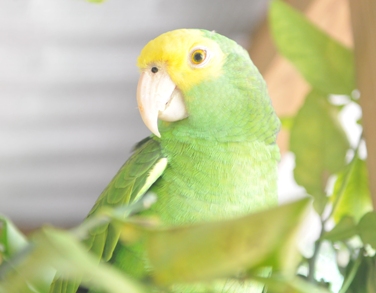On Friday we received the first of hopefully many yellow-headed amazons (Amazona oratrix belizensis)
Well cared for, of undetermined sex and probably around 3 or 4 years old, this one is a sweetheart. She goes by the name Lorito (which is normal for Belize) and has a small vocabulary which I'm sure will get bigger as her confidence in her new home grows. I've assigned the female gender because she is so gentle and a little nervous. She came from an anonymous donor, so the history will remain limited. Suffice to say, she is Numero Uno.

Now I really want to get started on the breeding programme. I spent a couple of days last week and again this morning ploughing through documents on the population numbers of oratrix. There is a huge hole in the figures and research and still the numbers are horribly low. Local reports from friends, tour guides, resort owners, in fact anyone I can get an answer out of, all tell the same story: "haven't seen any for years; we had a nest this year but it got chopped; you used to see them everywhere; my mother always had one in the house; I remember seeing them when I was a kid; my grandfather used to shoot them at weekends...
However you cut it, the future does not look good for our friend.
Another reason for my research was to try and iron out in my teeny tiny brain the confusion with the species in general. Is oratrix a subspecies of ochrocephala or not? Was A.o.belizensis originally just a hybrid of auropalliata that has since become isolated? Is it possible that A.o.hondurensis or A.a.oratrix occasionally use their wings to drift over our man-made borders? Are the differences between the subgroups and races minor, physical variations or genetic disparities? Therefore, if we failed to raise a captive bred indigenous population, would the loss of A.o.belizensis be a global loss of a specific species, or a local extirpation of a bird that would simply be an embarrassment for Belize? I guess the definitive answer is 'who cares, it's a loss that shouldn't happen' but the confusion over this particular species underlines the point I have been labouring for several years now: we don't know enough, we aren't doing enough and there are very, very few of them left, whichever one we are talking about.
So what now? Well, Geoff has finished his 475 sponsored tour of Belize. Geoff and I thank everyone who sponsored him, and helped to get the total raised toward the new aviary up to $2070US. Next week we begin construction. I've told Jerry he's making up the shortfall - he's happy in a scared sort of way, but he'll get over it. Geoff arrives in Belize next month and will begin his challenge all over again for real this time. He's a strange boy.
At the end of the day, regardless of whether we manage to generate a sustainable population of indigenous, releasable oratrix, we will have at least liberated many super-intelligent creatures from a horrible situation and maybe in the process provide some form of education for young Belizeans before it’s too late.
































